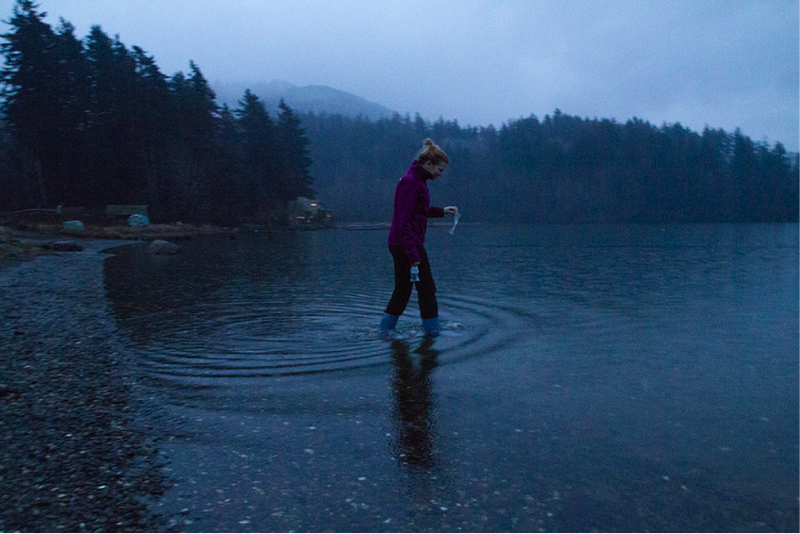Bay Pollution
Nonprofit foundation aims to improve water quality around Whatcom

STORY BY ALEX PETERSON
photos by Margaret Degman
Jessica Bayer wades into the water at Wildcat Cove, the morning waves lapping at her rain boots. She bends forward and dips a plastic bag into the water, holding it up to the light of her car headlights to make sure there isn’t any debris in the water. This is the only thing that might help in warning potential beach-goers about the dangers that lurk below the surface, the dangers which are too small to see.
Bayer, the Blue Water Task Force coordinator in Bellingham, calls it “citizen science.” The Blue Water Task Force is a volunteer-run group commissioned by the Surfrider Foundation that tries to raise awareness of the water quality problems in Bellingham. She organizes Task Force volunteers who test at six locations around Bellingham: Little Squalicum Beach, the Nooksack River Delta, the Padden Creek Mouth, Locust Beach, Mud Bay and Wildcat Cove.
Surfrider Foundation was formed in California in 1984 by a group of surfers who kept getting sick from the water they were surfing in. Today, Surfrider is an international non-profit which aims to improve water quality around the globe. The AS Surf Rider club is a club for students at Western who want to get involved with Surfrider or the Blue Water Task Force. The club helps organize volunteers for the Task Force and does beach cleanups.
The task force tests for Enterococcus, a fecal coliform bacterium, or, more simply, bacteria found in human and animal waste. E. Coli can also be present with Enterococcus, adding more potential for illness if humans come in contact with the water. All the test sites experienced readings of medium to high amounts of bacteria in the last recorded sample, according to the Blue Water Task Force’s test results,
The only thing stopping unsuspecting beach-goers from getting infected by Enterococcus or other bacteria in the water is the big yellow signs at some of the beaches. The signs display warnings about the risks of swimming in the water, telling visitors to refrain from water-related activities. Some of the illnesses associated with the bacteria in the water at these beaches range from stomach problems to meningitis, which kills about 165 people in the U.S. each year, according to the National Meningitis Association.

“A lot of parents like to let their kids swim in the water [at the sample sites], but if they knew what was in the water they really wouldn’t do it,” says Ethan Tracy, president of Western’s Surf Rider club. “It sucks having to step in that water [to collect the samples]; it grosses me out. If you can measure any amount of Enterococcus, it’s too high.”
The source of the bacteria is largely uninvestigated due to lack of funding, Bayer says, but at Wildcat Cove in Larrabee State Park, the Blue Water Task Force and Surfrider have begun combating the bacteria.
Eventually Surfrider got enough funding to do a stream segmenting project at Larrabee, and found that the levels of bacteria were high all the way to the border of the park, where they dropped down to normal levels, Bayer says. The project was a collaborative one among Surfrider, Whatcom County Health Department and the Ecology Beach Department. In the segmenting project, which involved testing the water quality from Wildcat Cove and intermittently throughout the stream, a raccoon latrine — a spot where all the raccoons in the area defecate — was discovered.
“When we did the stream segmenting we found the raccoon latrine and in it there were a lot of chip bags, marshmallow bags and other food scraps,” says Eleanor Hines, the Chapter Chair of Surfrider’s Northwest Straits chapter. “We talked to the park rangers and heard about raccoons taking campers’ food and fighting with them for their backpacks.”
The latrine is right along one of the streams that lead into Wildcat Cove, and after process of elimination, it was determined to be the cause of the high levels of Enterococcus at Wildcat Cove. During the summer months, Tracy and other Surfrider interns talk to campers about ways to keep their food safe from raccoons and try to raise awareness of the microscopic harm in the water. They also shovel the raccoon latrine, because all the raccoons use the same spot as a latrine.
The raccoon latrine is only one cause of high levels of Enterococcus at the Wildcat Cove sampling site, but Bayer and Tracy have thought about what else could be causing the high levels of bacteria at other locations. The high-industry area near Little Squalicum Beach on Bellingham Bay is one possibility, as is the population of homeless people in the downtown Bellingham area.
“Nothing has really been done to know what it might be,” Bayer says, citing the lack of funding as the problem.
Until the sources of the bacteria are found, the large yellow signs at each of the beaches are all that stands between unsuspecting swimmers and an illness or infection.